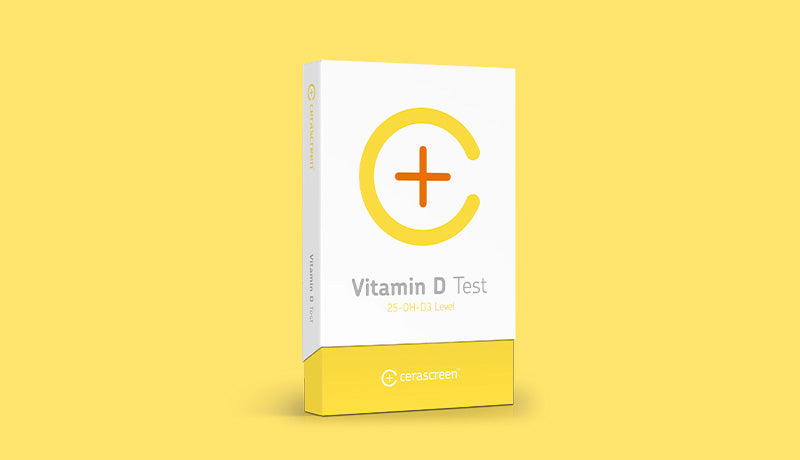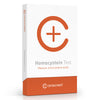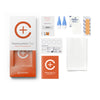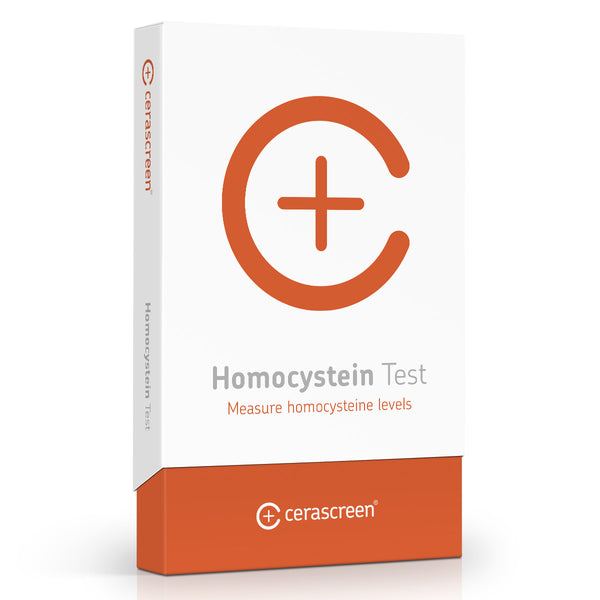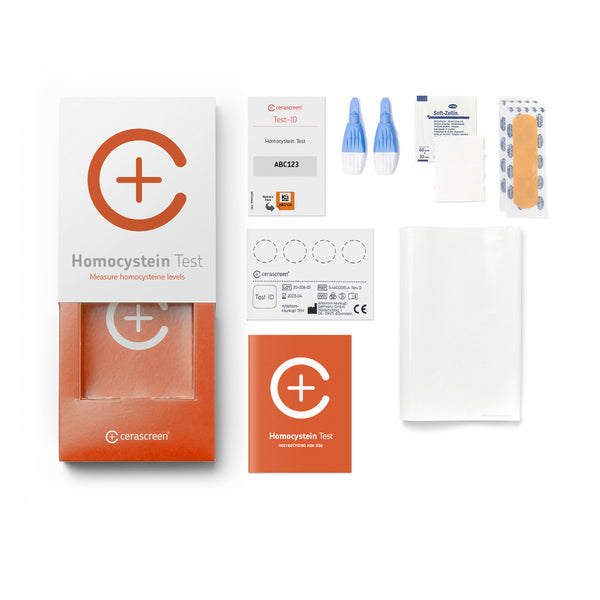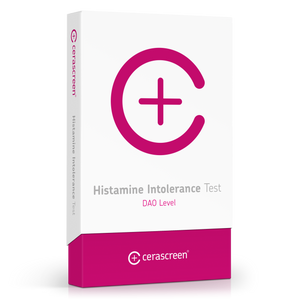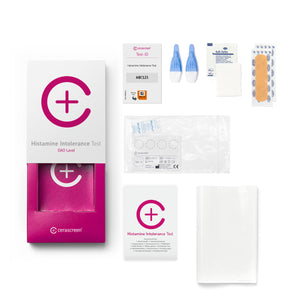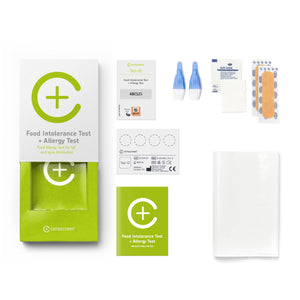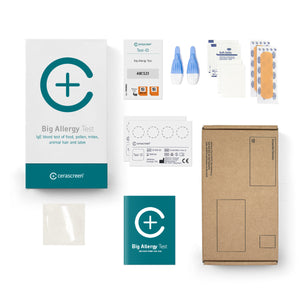product_id = 7961384517899variant_id = template_name =

Homocysteine Test
About the test
Prevent high blood pressure and arteriosclerosis. If there is too much of the amino acid homocysteine in the body, the risk of cardiovascular diseases increases, among other things. A lack of B vitamins is often behind the high homocysteine level, but it can sometimes also be existing diseases. If you know your homocysteine level, you can better assess these risks and take targeted countermeasures.
The cerascreen® homocysteine test is a home sampling and send-in kit. The homocysteine level in your blood is examined in the laboratory.
Homocysteine Test
- Take a blood sample at home – easy + discreet
- Homocysteine gives an indication of disease risks
- Professional analysis in a medical laboratory
- Digital result report with recommendations for prevention
- Result within 1 week after sample receipt
Benefits of the Homocysteine Test
Prevention is better than having to treat. An analysis of your homocysteine level supports you in pursuing targeted prevention – so that you can, ideally, act and reduce your risk of arteriosclerosis, high blood pressure, thrombosis, or other diseases.
You can take your sample for the cerascreen® homocysteine test at home: without visiting the doctor for hours and with no waiting! The test is a blood test: A little prick of the finger is enough. Analysis takes place in the medical laboratory.
Benefit from our expertise: cerascreen® is the market leader for medical sampling and send-in kits in Europe, with 9 years of experience in the development and evaluation of tests. We have developed more than 60 approved send-in test kits (medical products), evaluate 250,000 samples annually and are available in many European countries.

Result of the Homocysteine Test
As soon as your sample has been evaluated, you will receive your result report via the my cerascreen® app or in the user account of our secure online customer area. You can easily view the report on your smartphone, tablet, or computer, and read it in printed form if required.
The laboratory analysis tells you the concentration of the amino acid homocysteine in your blood and whether the value is within the reference range. With the help of our recommendations for action, you learn how you can lower an elevated homocysteine level again. Extensive health information explains how homocysteine is related to vitamins B6, B9, and B12.
Frequently asked questions about Homocysteine Test
Why test for homocysteine?
Homocysteine level is both a warning sign and can indicate a disease in and of itself. Researchers suspect that homocysteine in the body contributes to the development of diseases such as high blood pressure and arteriosclerosis.
The good news, however, is that in many cases you can lower your homocysteine levels again. This depends on the cause behind the increased values. For example, this could be lack of B vitamins and certain diseases or medications.
Who should take the test?
Homocysteine tests can be particularly interesting for people who already have an increased risk of cardiovascular disease, for example due to a genetic predisposition or previous illnesses. It also makes sense for people who already suffer from diseases such as cancer, osteoporosis, irritable bowel syndrome, or cardiovascular diseases.
If you belong to this group, you can identify another risk factor through an elevated homocysteine level and possibly take countermeasures.
A homocysteine test can also be useful for pregnant women. Because during pregnancy the need for B vitamins increases sharply, a lack of these vitamins can also lead to increased homocysteine levels.
How does the test work?
For the homocysteine test, you take a small blood sample from your fingertip using a lancet. Only a few drops of blood are required. Place the drops on two dry blood cards - this way you really only need to take very little blood and the sample will keep for a long time. Ideally, you should carry out the test on an empty stomach. It is best not to eat anything for 12 to 14 hours and avoid drinks with juice, sugar or milk before taking the sample.
The sample is sent to a specialised medical laboratory free of charge in a return envelope. The laboratory will analyse how high the concentration of homocysteine is and whether it is in the reference range or above. After the analysis, you will receive a notification and can access the results report via the online customer area or the my cerascreen® app.
How long does the analysis take in the laboratory?
Once your sample has arrived at the laboratory, it will be analyzed there by specialists. How long the analysis takes depends on the exact measuring method and the processes in the laboratory.
If the sample is sent on the correct days (Sunday to Tuesday), this makes it easier for the laboratory to adhere to the times.
For the Homocysteine Test, the laboratory analysis is usually completed within 6 working days after the sample is received in the laboratory.
What does the result report tell me?
The result report of the test tells you what homocysteine level was measured in your blood. Homocysteine levels are measured in units of micromoles per liter (μmol/L). You will also find out whether your test result – compared to reference values – is normal, slightly elevated, elevated, or extremely elevated.
What recommendations do I receive?
The most important recommendation for elevated homocysteine levels is: Find the cause! You can only take effective countermeasures if you find out what is causing the elevated values. A common cause is deficiency in vitamins B6, B9, and B12. In the results report, you will receive tips on how to correct these deficiencies with a change in diet or with supplements.
It is best to have a doctor examine you as well – your doctors can take into account your individual requirements, your history and your symptoms, and underlying diseases. Causes include chronic kidney disease, genetic disorders, and an underactive thyroid.
What does the homocysteine level tell you?
Homocysteine is an amino acid that occurs naturally in the human body. Different from essential amino acids, we do not have to supply homocysteine through food. It is a metabolite that is created when other amino acids are broken down and that the body uses to build new proteins, among other things.
However, slightly elevated homocysteine levels in the blood can be problematic. Too much homocysteine can damage blood vessels and increases the risk of high blood pressure and arteriosclerosis, among other things. Medicine even has its own term for elevated homocysteine levels: Homocysteine anemia.
Which vitamins are related to homocysteine?
Deficiencies in three B vitamins may be related to elevated homocysteine levels:
- Vitamin B6 found in meat, fish, vegetables, nuts, and whole grains.
- Vitamin B9 (folate), which is mainly found in green leafy vegetables, fruit, whole grain products, and nuts. The artificially produced variant of vitamin B9 is called folic acid and is recommended for pregnant women, among other things.
- Vitamin B12, which people have to get from animal products, therefore vegetarians and vegans often lack it. People who are vegan must take the vitamin through supplements.
If your homocysteine level has been determined to be too high, it may be worth examining your supply of these three vitamins as well.
How can I lower my homocysteine level?
How you can lower your homocysteine level is very individual. It mainly depends on the cause of the elevated level.
If the homocysteine level has risen due to a vitamin B deficiency, for example, it will usually fall again once the deficiency has been corrected. Quitting smoking also helps: Smoking contributes to vitamin B deficiency.
In other cases, it may be necessary to seek medical attention for conditions such as kidney disease or an underactive thyroid. Medications can also increase homocysteine levels. If you take medication consistently, talk to your doctor about whether the medication might affect your homocysteine. Sometimes it can make sense to switch to a different active ingredient.
What does high homocysteine level mean during pregnancy?
It is also a good idea for women who want to have children to test their homocysteine levels. Pregnant women whose homocysteine levels are too high have an increased risk of complications during pregnancy. In addition, the need for vitamin B12, B9, and B6 is significantly increased during pregnancy and breastfeeding. For pregnant women, it can therefore be particularly worthwhile to pay attention to the homocysteine level.
In general, it is recommended for pregnant women to take folic acid to meet their increased need for vitamin B9. This not only counteracts an elevated homocysteine level, but also counteracts malformations in the unborn child. This is already recommended while trying to get pregnant, since the need for folate increases right at the beginning of pregnancy.
For whom is the test not suitable?
The homocysteine test is not or only partially suitable for certain groups of people:
- People with infectious diseases such as hepatitis and HIV must not take the homocysteine test.
- People with hemophilia should not take the homocysteine test.
- The homocysteine test is not suitable for children under the age of 18.
The test is not intended to diagnose diseases. For example, if you suffer from severe pain or signs of paralysis, seek medical advice.
Why are children under 18 not allowed to take the test?
Our tests are not suitable for underage children and adolescents under the age of 18. Under 18s cannot activate the tests online and therefore cannot receive a test result. We ask that you do not administer the tests to your children either.
Children and adolescents need much closer supervision and counselling regarding medical tests and their interpretation. Testing with lancets and chemicals is not without risk and would need to be closely supervised by guardians. In addition, the reference values we give are always based on adult data. In the case of children, the risk of misinterpreting the results would be very high.
We want to fulfil our responsibility as a provider of medical products and ensure that children and adolescents are not unsettled by measurement results that are difficult for them to interpret. Since we cannot control whether the minors' legal guardians actually consent to the test being carried out and supervise them, we exclude tests for under 18s altogether.
If you are under 18 and have purchased a test, please contact our customer support.
Why does it take up to a week for the sample to reach the lab?
Please bear in mind that your results will not be analyzed in the UK but in Germany. For that reason, it can take up to a week for the sample to arrive at the lab. This does not affect the stability of the samples, as the method we are using is optimized for long transports.
Initially, your sample is sent to our collection center in the UK. From there, it is shipped to our central sample sorting facility in Germany, which then distributes samples to our partner laboratories. Once your sample is analyzed there, you will receive a notification and can access your result online.
Please check your mailbox regularly. We will notify you as soon as your sample is sent, arrives, or is analyzed.
Why does the test have an expiration date?
The cerascreen® test kits are CE-marked medical devices, which in turn include other certified medical components such as lancets, patches, and alcohol swabs used in blood tests.
Like most medical devices, these components have an expiration date to ensure that they remain safe and effective. Many of our sample carriers – such as dried blood cards or sample tubes – are chemically treated to keep your sample stable and analyzable in our laboratory. Over time, environmental factors can affect this treatment and compromise accuracy.
Our sterile, single-use lancets also carry an expiration date to guarantee sterility and safe use up to that time.
This is how it works
1. Test at home
Your test kit contains everything you need to draw a small sample of blood from your fingertip. Then send the sample back to us free of charge in the enclosed return envelope.
2. View results online
After the evaluation in the medical specialist laboratory, you will have online access to your personal result report.
3. Act
Your access to the test results and the evidence-based findings and tips to improve your health: the my cerascreen® user profile on our website or our app.

